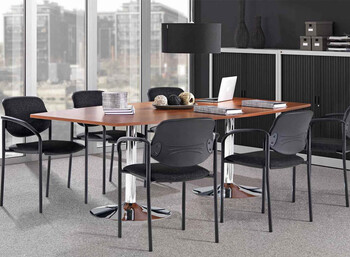Take measurements. Use a tape measure, yardstick, or meter stick to measure the length and width of your room. Also account for the dimensions of any alcoves or other recessed spaces in the room.
Create a floor plan. You can use formal grid paper, but you can also sketch it out on notebook paper or plain printer paper. Determine how much space you can spare for furniture and sketch out a few different ways that furniture can fit into the room. You should also factor in at least one yard (1 meter) of free space in between pieces of furniture. Anything smaller than that will make you feel as though you have to squeeze in between your furniture as you walk.
Check your doorways. Measure how wide your doorways are to prevent potential delivery mishaps. You do not want to purchase a piece of furniture only to discover that you cannot get it into your house.
Stage your living room. After determining how much space you can spare for furniture and where you want potential pieces to go, mark those spaces on the floor to get a better visual. Use painter's tape or spread out sheets of newspaper.
Think about how the room will be used. If your living room will act as a daily family hangout, you will need sturdy, stain-resistant furniture, especially if your kids are still young. On the other hand, if your living room will only entertain the occasional guest, you can opt for more fragile pieces made with delicate fabrics.
Note the room's natural architecture. Some rooms contain built-in design elements that may help you determine the type of furniture that will look best inside the room. For instance, if you have a rustic fireplace, cabin décor may be a better option than stark modern furniture. Modern furniture may be the best option for a living room of an apartment with a view overlooking the city, however.
Create a floor plan. You can use formal grid paper, but you can also sketch it out on notebook paper or plain printer paper. Determine how much space you can spare for furniture and sketch out a few different ways that furniture can fit into the room. You should also factor in at least one yard (1 meter) of free space in between pieces of furniture. Anything smaller than that will make you feel as though you have to squeeze in between your furniture as you walk.
Check your doorways. Measure how wide your doorways are to prevent potential delivery mishaps. You do not want to purchase a piece of furniture only to discover that you cannot get it into your house.
Stage your living room. After determining how much space you can spare for furniture and where you want potential pieces to go, mark those spaces on the floor to get a better visual. Use painter's tape or spread out sheets of newspaper.
Think about how the room will be used. If your living room will act as a daily family hangout, you will need sturdy, stain-resistant furniture, especially if your kids are still young. On the other hand, if your living room will only entertain the occasional guest, you can opt for more fragile pieces made with delicate fabrics.
Note the room's natural architecture. Some rooms contain built-in design elements that may help you determine the type of furniture that will look best inside the room. For instance, if you have a rustic fireplace, cabin décor may be a better option than stark modern furniture. Modern furniture may be the best option for a living room of an apartment with a view overlooking the city, however.



